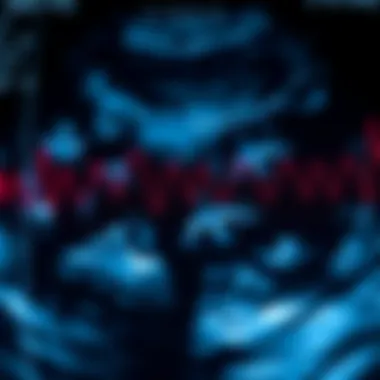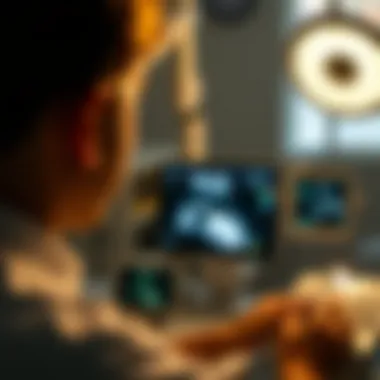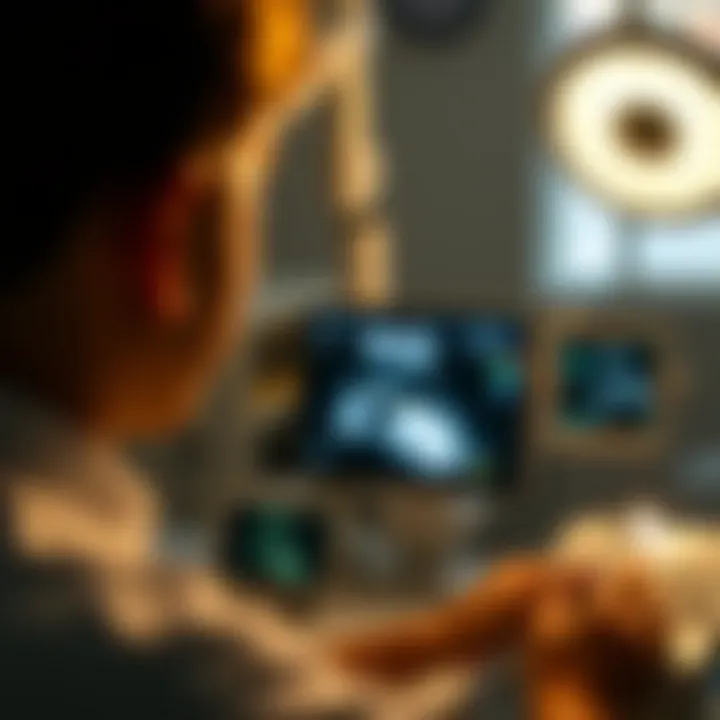Understanding Ultrasound Imaging: A Comprehensive Overview


Intro
Ultrasound imaging has significantly transformed the landscape of diagnostics and treatment in various fields including medicine and biological research. In essence, this technology employs high-frequency sound waves to visualize organs, tissues, and blood flow, providing real-time insights into the human body and other biological systems. Its non-invasive nature, speed, and versatility make it a favorable choice for clinicians and researchers alike.
As this article unfolds, the discussion will begin by outlining the foundational concepts surrounding ultrasound technology, delve into its scientific principles, and explore its wide-ranging applications. Furthermore, it will highlight recent advancements and the educational pursuits necessary for mastering ultrasound techniques. Challenges and ethical considerations that may arise in practice will also be scrutinized, ensuring a well-rounded understanding of the topic.
In today’s rapidly evolving medical landscape, staying informed about emerging trends in ultrasound imaging is vital not only for aspiring practitioners but also for seasoned professionals eager to enhance their skill set.
This overview aims to equip you with a comprehensive understanding necessary to navigate the complexities and capabilities of ultrasound imaging.
Preface to Ultrasound Imaging
Ultrasound imaging has emerged as a cornerstone of modern medical diagnostics and therapeutic applications. Its significance extends beyond its functionality; it embodies a non-invasive, real-time observation technique that can provide crucial insights into the human body. Understanding this technology requires an examination of its definition, purpose, and historical evolution.
Definition and Purpose
Ultrasound imaging, commonly known as sonography, is a method that utilizes high-frequency sound waves to visualize internal structures. These sound waves are emitted by a transducer, reflecting off tissues and creating echoes that are transformed into images using advanced computer algorithms. The primary purpose of ultrasound imaging is to aid in diagnosis, but it extends its usefulness to several other fields, including monitoring fetal development, assessing organ health, and guiding interventional procedures.
One significant advantage of ultrasound is its safety. Unlike X-rays or CT scans, it does not involve ionizing radiation, making it a preferred choice in situations where imaging is required without risk to patient safety. This feature is particularly crucial when imaging vulnerable populations, such as pregnant women and infants.
Nevertheless, it’s worth noting that ultrasound has its limitations. The quality and clarity of images can vary greatly depending on several factors, including the skill of the operator, the quality of equipment, and the patient's anatomical characteristics. Despite these hurdles, it remains a first-line diagnostic tool in many clinical settings, reinforcing its value in patient care.
Historical Context
The origins of ultrasound can be traced back to the early 20th century, primarily in maritime applications where sonar technology was developed to detect submarines. The leap from this maritime context to medical use signifies a fascinating evolution. It wasn't until the 1950s that researchers like Dr. John Wild began experimenting with ultrasound for medical diagnostic purposes.
This era marked a turning point as the advancement of imaging technologies rapidly progressed. In 1963, the development of real-time imaging shifted ultrasound from a static technique to a dynamic one, allowing practitioners to view moving organs and even fetuses in utero. Over the decades, improvements in transducer design, computing power, and image processing algorithms have contributed to the widespread adoption of ultrasound in healthcare.
Knowledge of ultrasound's history enriches our understanding of its clinical relevance today. It reflects a journey from rudimentary sound wave applications to critical imaging techniques fundamental in various diagnostics and treatments. It emerges not merely as a tool of technological advancement but one of profound impact on medical practice and patient outcomes.
Understanding the history of ultrasound imaging is vital for appreciating its current place in medicine and how it serves as a bridge between technology and patient care.
Understanding the history of ultrasound imaging is vital for appreciating its current place in medicine and how it serves as a bridge between technology and patient care.
In summary, the introduction to ultrasound imaging sets the stage for deeper exploration into its principles, technology, and practical applications. It reveals not only its profound utility in the medical field but also the evolution that has led to its current capabilities. As we delve further into the specifics of ultrasound imaging, the foundational knowledge gained here will enhance comprehension of the broader topics that follow.
Fundamental Principles of Ultrasound
Understanding ultrasound imaging hinges upon the fundamental principles that govern its operation. These principles are not merely academic; they are the bedrock upon which all applications of ultrasound rest. Gaining insight into how sound waves operate and their specific behaviors in various mediums enriches comprehension of ultrasound technology and its practical implications in fields like medicine and biological research.
Basic Physics of Sound Waves
To appreciate ultrasound, one must first grasp the basic physics of sound waves. Sound is a mechanical wave that travels through a medium, such as air, water, or tissue, by vibrating the particles within that medium. Generally, there are three key characteristics to consider:
- Frequency: This determines the pitch of the sound. Higher frequencies yield better resolution in imaging but have limited penetration depth. In contrast, lower frequencies can penetrate deeper but at the cost of reduced image quality.
- Wavelength: This is closely related to frequency; shorter wavelengths can resolve finer details. Ultrasound typically operates at frequencies ranging from 2 MHz to 20 MHz, striking a balance between resolution and depth.
- Amplitude: This indicates the strength of the wave, with higher amplitude correlating to a louder sound. In imaging, it reflects the intensity of the returning echoes, which can translate into varying shades of gray on a screen.
These core attributes help professionals select appropriate settings for diagnostics. For instance, while examining a fetus during pregnancy, a higher frequency might shine brightest, providing clear imagery, whereas deeper structures may require a lower frequency.
Generation and Propagation of Ultrasound
The heart of ultrasound technology lies in how these sound waves are generated and propagated. Ultrasound machines use a component called a transducer, which converts electrical energy into mechanical energy, specifically sound waves. Here’s how it works:
- Transducer: The device consists of piezoelectric crystals that deform in response to electrical voltage, generating high-frequency sound waves. When these waves encounter different tissues in the body, some are reflected back, while others penetrate deeper.
- Propagation: As sound waves travel through the body, they behave differently depending on the medium's density and composition. For example, sound travels faster in liquid than in soft tissue, and different tissues reflect sound waves at varying intensities. This fluidity allows for the creation of images based on how the echoes return to the transducer.
- Echo Reception: The returning echoes are collected by the transducer and converted back into electrical signals. These signals are then processed by the ultrasound machine to create visual images on a screen, enabling practitioners to diagnose various conditions.
By understanding the dynamics of ultrasound generation and propagation, practitioners are better equipped to interpret images accurately and make informed clinical decisions.
"The beauty of ultrasound lies not only in its ability to create images but also in its fundamental reliance on the physics of sound that governs it."
"The beauty of ultrasound lies not only in its ability to create images but also in its fundamental reliance on the physics of sound that governs it."
Core Components of Ultrasound Imaging Systems
In ultrasound imaging, the core components serve as the backbone of the diagnostic process. They work cohesively to convert sound waves into visual images, thus allowing clinicians to analyze internal structures without invasive procedures. This section delves deeper into the essential elements that comprise ultrasound imaging systems. Understanding these components can enhance the efficacy of many medical practices, from prenatal imaging to emergency diagnostics.
Transducer Technology
The transducer is arguably the heart of an ultrasound system. It is a device that both emits and receives sound waves, transforming electrical energy into acoustic energy and vice versa. Different types of transducers exist, including linear, curvilinear, and phased array transducers, each having its own advantages depending on the medical application. For instance, a curvilinear transducer is often utilized in abdominal examinations, where a wider field of view is necessary, whereas a phased array transducer is more suited for cardiac imaging due to its ability to generate images in tight spaces.
"Transducer technology is crucial for producing high-quality images that enhance diagnostic accuracy."
"Transducer technology is crucial for producing high-quality images that enhance diagnostic accuracy."
The efficiency of a transducer relies heavily on its frequency range. Higher frequencies provide better image resolution, but at the cost of penetration depth. Conversely, lower frequencies, while less detailed, allow for deeper tissue visualization. Thus, selecting the right transducer impacts both image clarity and diagnostic outcomes. The continual advancement in transducer technology ensures that patients receive the best possible care, with recent innovations including 3D and 4D imaging capabilities.
Signal Processing Techniques


After the transducer has done its part, the next step involves signal processing to refine the raw data received. This is a vital aspect that turns sound waves into comprehensive images interpretable by the clinician. Not only does signal processing enhance image quality, but it also filters out noise that could lead to misinterpretation.
Among the various techniques used are:
- Time Gain Compensation (TGC): Adjusts the brightness of echoes from different depths, allowing for uniform image quality across various tissue layers.
- Harmonic Imaging: This technique utilizes the harmonics of the transmitted frequency to improve resolution, particularly useful in challenging imaging scenarios.
- Doppler Processing: Essential for measuring blood flow—this method analyzes the frequency shift in returned signals caused by moving blood cells, aiding in the diagnosis of various cardiovascular conditions.
Thus, effective signal processing is not just about clarity; it directly contributes to enhanced diagnostic capabilities, giving clinicians the tools to make informed decisions.
Display Systems
The final component in the chain of capturing ultrasound images is the display system. It plays a crucial role in how the processed signals are represented on screen for evaluation. High-quality displays allow for fine detail to be easily viewed and interpreted, thus directly influencing the diagnostic effectiveness of ultrasound imaging.
Modern ultrasound machines often incorporate LED or LCD screens that provide vibrant, detailed images with higher resolution than their older counterparts. Advanced systems may include features like:
- Touchscreen interfaces for more intuitive navigation.
- Multispectral imaging capabilities that allow visualization of various types of tissues and pathology in one interpretation.
- Cloud storage options, enabling easy sharing of images among healthcare professionals for collaborative decision-making.
Overall, the robustness of display systems contributes immensely to patient outcomes, ensuring that critical information is accurately assessed and communicated. In short, the synergy between transducer technology, signal processing, and display systems creates a sophisticated framework that propels the field of ultrasound imaging into new frontiers.
Applications of Ultrasound Imaging in Medicine
The realm of medical imaging has undergone a significant transformation over the years, with ultrasound emerging as an invaluable tool in various medical disciplines. Ultraound imaging stands out due to its non-invasive nature and ability to provide real-time feedback. It allows health professionals to visualize internal structures and organs without resorting to radiation or invasive procedures. This section delves into the multifaceted applications of ultrasound in medical practice, each with its own unique contributions to patient care and diagnostics.
Diagnostic Applications
Obstetrics and Gynecology
In obstetrics and gynecology, ultrasound serves as a cornerstone for prenatal care. This imaging modality enables healthcare providers to monitor fetal development, assess gestational age, and identify potential anomalies early in pregnancy. One key characteristic of obstetric ultrasound is its capacity to provide real-time images of the fetus, which can reassure expectant parents and guide intervention if needed.
The unique feature of obstetrics ultrasound is its ability to offer a non-invasive peek into the womb, allowing for detailed visualization as development progresses. However, while it's heralded for its benefits, one must consider the challenges; for instance, factors like maternal obesity can hinder image quality, potentially complicating interpretations.
Cardiology
Moving on to cardiology, ultrasound—known in this field as echocardiography—plays a critical role in assessing heart health. It allows for the evaluation of cardiac function by enabling the visualization of the heart's structure and motion. A highlight for clinicians is the real-time imaging that echocardiography provides, making it essential for diagnosing conditions such as heart valve defects or heart muscle diseases.
What makes echocardiography particularly advantageous is its non-invasive approach, combined with the capacity to evaluate a patient’s heart without exposure to ionizing radiation. Nevertheless, it does come with its own set of limitations; particular anatomical challenges can obscure views, leading to incomplete assessments.
Emergency Medicine
In the sphere of emergency medicine, ultrasound is widely recognized for its rapid deployment and effectiveness in life-threatening situations. Point-of-care ultrasound can facilitate quick assessments, providing vital information that informs immediate clinical decisions. For example, detecting fluid in the abdomen or chest can speed up the diagnosis of conditions like internal bleeding or pleural effusion.
The key characteristic of ultrasound in emergency contexts is its portability and the speed with which results are obtained, crucial features in time-critical situations. Yet, the interpretation requires experience and skill; misdiagnosis can occur if findings are not accurately evaluated in the context of a patient’s clinical picture.
Therapeutic Uses
Ultrasound-Guided Procedures
Ultrasound extends beyond diagnostics into therapeutic applications, where it plays a pivotal role in guiding procedures. Ultrasound-guided interventions allow practitioners to perform tasks such as aspirations or injections with enhanced precision. By providing real-time imaging of the target area, this method not only increases the success rate of the procedure but also decreases the risk of complications.
The notable advantage of ultrasound-guided procedures lies in their ability to minimize patient discomfort and reduce recovery time. However, it's essential to acknowledge that not all practitioners may possess the required expertise, which can affect the efficacy of the procedure.
Physical Therapy
In physical therapy, ultrasound has made significant strides as a therapeutic modality. It can reduce pain and promote healing by delivering sound waves to affected areas, enhancing tissue repair. A defining characteristic of this application is its versatility; ultrasound can be used for a range of conditions, from musculoskeletal injuries to post-operative recovery.
The benefit is clear: using ultrasound therapy can lead to improved healing times and enhanced patient satisfaction. However, practitioners need to apply it judiciously, as overuse can lead to thermal injuries or tissue damage. Moreover, understanding individual patient responses is critical in optimizing treatment plans.
Ultrasound in Biological Research
The integration of ultrasound technology in biological research has revolutionized the way scientists observe and interact with living organisms. This non-invasive imaging method enables researchers to visualize anatomical structures and physiological processes in real time without altering the subject's environment. Ultrasound in biological research is pivotal due to its versatility and accuracy. You can appreciate its role across various disciplines, including zoology and ecological studies, reflecting how fundamentally it reshapes our understanding of life.
Applications in Zoology
In zoological studies, ultrasound is particularly invaluable for examining animal physiology and behavior. Researchers leverage ultrasound to gather data on reproductive health, develop understanding of animal movements, and track growth rates in various species. For instance, studies on marine mammals often utilize ultrasound to monitor pregnancy and fetal development without intruding on their natural behaviors. This is crucial, as stressing animals can skew data or compromise their well-being.
- Fetal Imaging: Ultrasonography allows for early detection of pregnancies in species like dolphins or seals, providing insight into their reproductive cycles.
- Behavioral Studies: By using ultrasound to observe animals underwater, researchers can understand communication methods, for example, echolocation in bats.
- Morphological Analyzes: Non-invasive methods yield accurate measurements of internal structures, enabling biologists to compare characteristics across populations.
The implications of ultrasound in zoology are profound, allowing scientists to collect rich data without hampering the animals' natural habitats. Consider it a window into a world that was previously hard to access.
Ecological Studies
When it comes to ecological research, ultrasound serves a vital role in monitoring habitats and assessing ecosystem health. This imaging technique is employed to survey wildlife populations, track changes in biodiversity, and study fluid dynamics in ecosystems. One key area is in river or marine ecology, where researchers analyze fish populations without dredging the waters. This minimally intrusive approach is not just about preserving the habitat; it also ensures the accuracy of the findings.
- Biodiversity Assessment: Ecologists use ultrasound to identify various species present in a habitat, crucial for conservation efforts.
- Habitat Monitoring: By inspecting the physical structures within aquatic environments, researchers can note changes over time due to external stressors, such as pollution.
- Inter-species Interactions: The ability to visualize interactions among species through sound waves aids in understanding food webs and their stability.
Through these methods, ultrasound reveals hidden dynamics of ecosystems, leading to targeted conservation strategies. Insight derived from such research can have long-lasting impacts on ecological policies and conservation plans.


"Ultrasound proves itself not merely an imaging technique, but a lens through which we can witness the intricacies of life itself."
"Ultrasound proves itself not merely an imaging technique, but a lens through which we can witness the intricacies of life itself."
Overall, the role of ultrasound in biological research underscores a shift towards more humane and effective ways of studying living organisms. It opens avenues for researchers to delve deeply into the biological workings of life, enhancing our comprehension of the natural world.
Educational Pathways in Ultrasound Imaging
The realm of ultrasound imaging has expanded tremendously in recent years, leading to increased demand for skilled professionals. Understanding the educational pathways in this field is crucial for both newcomers and seasoned practitioners aiming to advance their careers. With technological advancements and evolving healthcare needs, proper education not only ensures competency but also enhances one’s ability to contribute meaningfully to patient care and research.
Formal Education Requirements
To embark on a career in ultrasound imaging, one must typically complete a formal education program. Most practitioners begin their journey by obtaining an associate's or bachelor's degree in diagnostic medical sonography or a related field. These programs usually encompass essential topics such as anatomy, physiology, and the principles of sonographic imaging. Here are some key aspects of formal education in ultrasound:
- Accreditation: Opting for programs accredited by the Commission on Accreditation of Allied Health Education Programs (CAAHEP) is pivotal. This accreditation often assures that the curriculum meets industry standards, thus better preparing students for roles in healthcare.
- Clinical Training: Hands-on experience is integral to education. Most programs require a clinical component where students practice skills in real-world settings, honing their technical abilities while interacting with patients. This exposure is vital for building confidence and proficiency.
- Certification: After completing an educational program, certification from organizations like the American Registry for Diagnostic Medical Sonography (ARDMS) can enhance employability. Certification serves as a benchmark for professional competence, and is often preferred by employers.
To gain insights into the specific programs available, prospective students may refer to resources like National Ultrasound for program directories and comparisons.
Continuing Professional Development
In the fast-paced world of medical imaging, staying current with technology and techniques is paramount. Continuing professional development (CPD) allows ultrasound practitioners to refine their skills, understand new developments, and maintain certification. Here are several facets of CPD:
- Workshops and Seminars: Participating in hands-on workshops and attending seminars on recent advancements in ultrasound technology are great ways to enrich knowledge. These events often feature leading experts who share current trends and emerging techniques that can significantly impact practice.
- Online Courses: With the rise of digital learning platforms, many professionals opt for online courses to enhance specific skills or explore new techniques at their own pace. Institutions such as Sonography.org offer various e-learning modules geared toward continuing education.
- Peer Networking: Joining professional organizations not only allows for networking but also grants access to a repository of resources. Membership in associations such as the Society of Diagnostic Medical Sonography (SDMS) can assist practitioners in connecting with peers across the globe, sharing insights while keeping abreast of the latest industry changes.
Ultimately, engaging in CPD is not merely a professional requirement but a strategic approach to remain competitive in the evolving landscape of ultrasound imaging.
"Education is the most powerful weapon which you can use to change the world." – Nelson Mandela
"Education is the most powerful weapon which you can use to change the world." – Nelson Mandela
By investing time in both formal education and ongoing learning, professionals not only bolster their own career trajectories but also significantly improve patient care outcomes and contribute to the larger medical community.
Skill Development for Ultrasound Practitioners
The intricate world of ultrasound imaging requires a set of refined skills for practitioners who aspire to make a significant impact in the field. Skill development in this area is not just important; it’s essential for delivering high-quality patient care. As healthcare continues to evolve, ultrasound practitioners must adapt, learn, and hone their abilities to ensure they provide accurate diagnoses and effective treatments. Thus, focusing on specific elements of skill development brings about many benefits while navigating various considerations unique to the profession.
Technical Proficiency
Technical proficiency in ultrasound imaging is a fundamental pillar of the profession. This involves a comprehensive understanding of ultrasound technology and your ability to use it effectively. Practitioners must become adept at operating ultrasound machines, interpreting images, and understanding the nuances of sound wave interactions with human tissue.
To develop technical skills, practitioners often engage in hands-on training and simulated experiences. These include:
- Shadowing seasoned professionals to observe best practices and real-world applications.
- Participating in workshops and courses specifically targeted at enhancing technical capabilities.
- Consistent practice underpinned by feedback from peers and mentors.
Moreover, staying updated with advancements in ultrasound technology, such as 3D imaging and portable devices, is crucial. This not only enhances the practitioner's skills but also improves the quality of patient evaluations. Therefore, continuous education and practical exposure are indispensable for technical proficiency, ultimately leading to better outcomes for patients.
Patient Interaction Skills
While technical know-how is vital, the importance of patient interaction skills cannot be overlooked. The ability to communicate effectively, empathize, and foster a trusting relationship with patients is paramount in ultrasound practice. Practitioners often operate in high-stress environments where patients may feel anxious or confused.
To strengthen patient interaction skills, practitioners should consider:
- Active listening: This helps in understanding patient concerns, making them feel heard and valued.
- Clear explanations: Describing procedures and what patients can expect can ease anxiety and build trust.
- Non-verbal communication: Body language and facial expressions play a crucial role in establishing rapport.
"In the practice of ultrasound, the image isn't everything. The patient’s experience matters just as much."
"In the practice of ultrasound, the image isn't everything. The patient’s experience matters just as much."
The integration of strong patient interaction skills not only improves patient satisfaction but also fosters better collaboration, which can lead to enhanced treatment pathways.
In summary, skill development for ultrasound practitioners encompasses both technical mastery and nurturing patient relationships. Each aspect reinforces the other, creating a holistic approach that significantly benefits patient care and clinical practices.
Challenges and Limitations of Ultrasound Imaging
Ultrasound imaging stands out in the realm of diagnostic tools, largely due to its non-invasive nature and ability to provide real-time imaging. However, it is not without challenges and limitations. Understanding these aspects is crucial for both practitioners and patients. Recognizing the boundaries of ultrasound technology helps in making informed decisions about its use, ensuring that it complements other diagnostic modalities effectively.
Technical Limitations
Although ultrasound has numerous advantages, technical limitations can impede its efficacy. Limitations arise from both the hardware and the software involved.
- Resolution: Ultrasound imaging technology carries intrinsic limitations related to spatial resolution. The clarity of images can be affected by the frequency of the sound waves used. Higher frequencies may provide better resolution, but they penetrate deeper tissues less effectively. Thus, a balance between depth and clarity often needs to be struck, potentially leading to compromised diagnostic visualization.
- Operator Dependency: The skill level and experience of the sonographer can profoundly affect the quality of ultrasound images. If the operator lacks experience, they might miss critical findings or misinterpret the images. This variability underscores how vital training is in the field.
- Patient Factors: Several patient-related factors can influence the quality of ultrasound imaging outcomes. For example, obesity or excessive gas in the intestines can impede the passage of sound waves and, subsequently, affect image quality. This emphasizes that ultrasound is not a one-size-fits-all solution.
"Despite its growing popularity, understanding where ultrasound falls short is necessary to maximize its potential."
"Despite its growing popularity, understanding where ultrasound falls short is necessary to maximize its potential."


Interpretative Challenges
Interpreting ultrasound images is complex and can pose substantial challenges. Even for seasoned practitioners, this process is fraught with hurdles.
- Variability in Anatomy: Human anatomy can vary significantly from one individual to another. What may appear as a concern in one person could be entirely normal in another. This anatomical variability poses a continuous challenge in validating findings during an ultrasound.
- Artifacts and Misleading Shadows: Ultrasound images are susceptible to artifacts—unwanted echoes that can lead to false conclusions. These artifacts could resemble pathological conditions, leading to unnecessary worry or, conversely, the overlooking of actual issues. Spotting these artifacts requires both skill and acute attention.
- Limited Scope of Diagnosis: While ultrasound imaging shines in certain applications such as obstetrics or cardiology, it has limitations in diagnosing some conditions. For example, assessing certain deep-seated masses or lesions may require supplementary imaging modalities, such as MRI or CT scans, to provide a comprehensive diagnosis.
Ethical Considerations in Ultrasound Imaging
In recent years, a robust awareness around the ethical dimensions of ultrasound imaging has emerged, directing focus towards the fundamental aspects of patient care and professional integrity. Engaging with ultrasound technology goes beyond mere image capturing and interpretation; it envelops the responsibilities that come with patient interactions, informed consent, and adhering to regulatory standards. These components are vital not only for ensuring the safety and rights of patients but also in promoting trust and accountability within healthcare settings. Navigating these ethical waters is crucial for every practitioner involved in ultrasound imaging.
Patient Privacy and Consent
The cornerstone of ethical practice in ultrasound imaging is safeguarding patient privacy and securing informed consent. This means practitioners must ensure that patients fully understand the procedure, its risks, and how their data will be utilized before any imaging takes place.
- Informed Consent: Proper communication is essential. A practitioner should be able to articulate the purpose of the ultrasound, the steps involved, and potential outcomes in a clear way that a patient can comprehend.
- Confidentiality: With the sensitive nature of the information obtained through ultrasound, it is paramount to uphold confidentiality. This involves not only storing data securely but also limiting access to those who absolutely need it in the context of patient care.
- Respect for Patient Autonomy: Patients should be granted the autonomy to make decisions regarding their care. This could mean having the option to decline specific procedures without undue pressure from healthcare providers.
"Patients have the right to say yes or no. It’s their body, and every practitioner should respect that."
"Patients have the right to say yes or no. It’s their body, and every practitioner should respect that."
These factors collaborate to foster a respectful atmosphere that empowers patients, which ultimately enhances their trust in healthcare systems.
Regulatory Compliance
Operating within the bounds of regulatory compliance is another critical aspect that binds ethical practice in ultrasound imaging. In various jurisdictions, there are stringent laws and guidelines established to protect both patients and practitioners.
- Understanding Legislations: Practitioners must stay informed about the laws governing medical imaging in their region. This includes pertinent privacy laws, healthcare regulations, and industry standards that govern ultrasound usage.
- Maintaining Standards: Compliance isn’t a one-time tick in a box; it requires continuous education and adherence to established protocols. The dynamic nature of technology and medical standards means ongoing training is essential.
- Accountability: Developing a culture of accountability within the workplace is critical. This can be achieved through regular audits and reflective practices that ensure all processes align with current regulations.
Future Directions in Ultrasound Technology
The landscape of ultrasound technology is rapidly evolving, harnessing advancements that promise to enhance diagnostic capabilities and broaden its applications in both clinical and research settings. This section delves into the significance of future directions in ultrasound technology, addressing the specific elements shaping this transformation, the benefits offered, and the important considerations that must be accounted for.
In recent years, we've witnessed an explosion of innovation in ultrasound imaging. As the healthcare sector increasingly leans toward non-invasive techniques, ultrasound's role becomes all the more crucial. By embracing emerging technologies, ultrasound could redefine how practitioners detect and treat a variety of conditions, from cardiology to obstetrics.
"The evolution of ultrasound technology opens doors not just to advanced imaging, but also to better patient outcomes and more personalized care."
"The evolution of ultrasound technology opens doors not just to advanced imaging, but also to better patient outcomes and more personalized care."
Advancements in Imaging Technologies
One of the most exciting areas of development in ultrasound is the enhancement of imaging clarity and precision. Traditional ultrasound has its limitations, such as operator dependency and variability in image interpretation. However, new technologies are directly addressing these issues. For instance, 3D and 4D ultrasound are allowing clinicians to visualize structures in a more realistic manner. This isn't just about aesthetics; advanced imaging facilitates better surgical planning and aids in more accurate diagnoses.
Another noteworthy advancement is the miniaturization of ultrasound devices. Portable ultrasound units, like those created by Butterfly Network, equip healthcare professionals on-the-go with powerful imaging tools. The potential for point-of-care applications is vast, as it enables practitioners in remote or underserved areas to access essential diagnostics without needing to rely on bulky machines.
Furthermore, elastography has gained traction in recent years. This innovative technique measures tissue stiffness, which can be pivotal in assessing liver fibrosis and other conditions. By incorporating elastography into routine practice, practitioners can glean more information from a single ultrasound exam, enhancing the overall diagnostic capability.
Integration with Artificial Intelligence
The integration of artificial intelligence (AI) into ultrasound technology is proving to be a game-changer. Machine learning algorithms can analyze vast libraries of ultrasound images, recognizing patterns that even the most practiced human eye might miss. This can lead to faster and more accurate diagnoses while reducing the burden on healthcare professionals.
AI can also enhance image quality by automatically optimizing settings such as gain and depth, tailoring the ultrasound experience to the specific patient. Consider the utility of AI-based assessment tools that can offer preliminary interpretations of ultrasound images. While a human specialist should always make final assessments, AI tools can serve as valuable assistants, expediting the diagnostic process.
Moreover, the potential for remote diagnosis and telemedicine is greatly enhanced through AI integration. Imagine a scenario where a sonographer in a rural clinic captures ultrasound images that an AI system quickly analyzes, leading to immediate feedback. This can significantly improve patient care, especially in areas where specialists are not readily available.
The End
As we wrap up this extensive exploration of ultrasound imaging, it is essential to note the significance of the conclusions we've drawn. The multifaceted nature of ultrasound technology is not merely an academic subject; it is a vital pillar in modern medicine, research, and education. From its initial discovery to the cutting-edge advancements today, ultrasound has continually adapted to meet the evolving demands of healthcare and scientific inquiry.
Summary of Key Insights
Throughout this article, we have dissected the core principles and components of ultrasound imaging systems. Key insights include the following:
- Foundational Principles: Understanding sound wave physics is paramount, as it dictates how ultrasound functions. The technology relies on transducers and signal processing to create visual representations of internal structures.
- Diverse Applications: Ultrasound serves myriad roles across various fields, from prenatal imaging in obstetrics to assessing cardiac function in cardiology. It even extends into ecological research, showcasing the versatility of the technology.
- Skill Development: For professionals in the field, acquiring not just technical skills but interpersonal skills is crucial. This blend ensures effective patient interaction and confidence in performing procedures.
- Challenges: Despite its advancements, ultrasound comes with limitations that can affect interpretative accuracy and confidentiality issues related to patient privacy.
These insights not only encapsulate the technical knowledge necessary to understand ultrasound but also highlight its role in enhancing patient care and research methodologies.
The Importance of Continued Exploration
In an ever-evolving field like ultrasound imaging, the importance of continued exploration cannot be overstated. As technology progresses, new applications emerge, demanding that professionals stay abreast of the latest techniques and findings. Continuous education and training will enable practitioners to refine their skills and remain competent in an environment where advancements occur at breakneck speed.
Continued research into the ethical implications and patient-centric practices is equally crucial. Balancing technological capabilities with a robust respect for privacy and consent will not only build trust in the physician-patient relationship but also foster innovation that aligns with ethical standards.
Investing time and resources into further studies and professional development is paramount for current and future practitioners. The field's dynamic nature means that those who pursue lifelong learning will likely be at the forefront of groundbreaking discoveries and practices, positively impacting countless lives.
The journey into ultrasound imaging is ongoing, filled with potential for growth and innovation. Engaging with this field and its continuous evolution is not just beneficial; it is essential for anyone committed to making a difference in healthcare or related research sectors.
"Innovation distinguishes between a leader and a follower." - Steve Jobs
"Innovation distinguishes between a leader and a follower." - Steve Jobs
As we conclude, remember this is not merely the end of a discussion but rather an invitation to dive deeper into the world of ultrasound imaging, acknowledging both its triumphs and the challenges that lie ahead.







